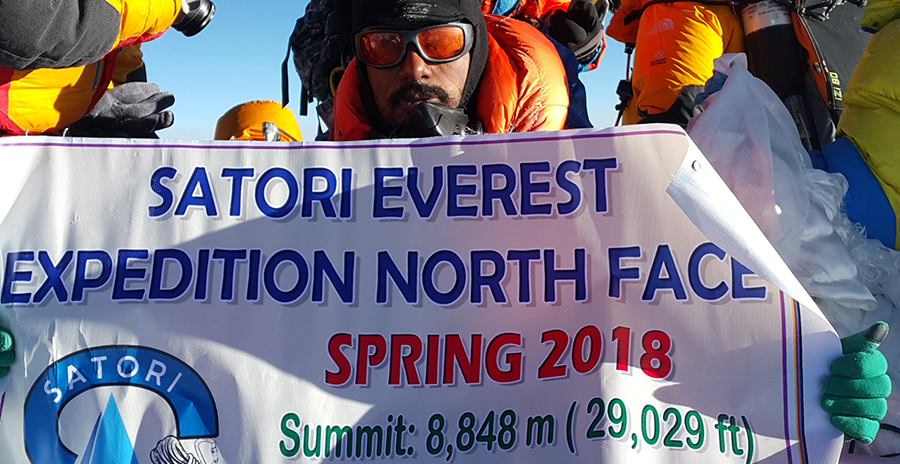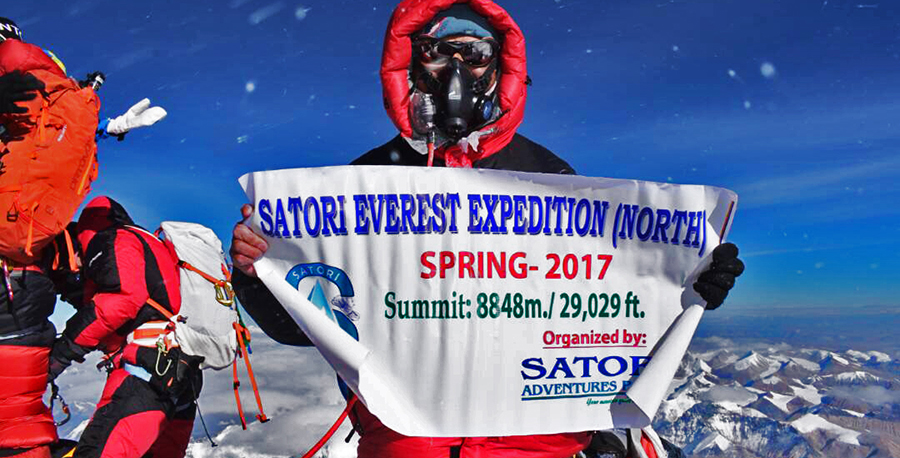Close your eyes for a moment. Now, imagine yourself on the top of the world. Your feet rooted to the highest point on Earth through your grit and determination. Walking among the clouds. Seeing what you know is the same sky you always see but gazing in awe at how different it looks. Knowing that this is a sight and feeling only few in the world experience who dares to accept Mount Everest expedition challenges.
Mount Everest is – to state the obvious – a major mountaineering destination for mountaineers. It is the benchmark that each mountaineer dreams to set and reach. And it is clearly not for everyone. But you may be one of the hungry ones, those chosen few who feel the call to stand on our beautiful planet’s mightiest peak.
The decision to climb Mount Everest is difficult enough. But the hard part has just begun. Climbing Mount Everest is no easy feat, imposing intense physical and mental challenges and unpredictable environmental conditions from beginning to end, for a period of at least two months, on even the world’s toughest climbers.
It is therefore imperative that you select not only a tour operator, but a partner, to help fulfill your Mount Everest expedition dreams wisely.
Satori Adventures (P) Ltd, although established relatively recently in 2015, has fulfilled the dreams of over 100 Everest climbers and has a dedicated team with more than a decade of mountaineering experience, including significant experience with 8,000 and 6,000 meter peaks. Its founder, Rishi Bhandari, has vast experience in all aspects of mountaineering and tour operation. Satori was founded with a very clear mission to deliver to each of its clients a mountaineering or trekking experience of a lifetime. Having served clients from all over the world, and with over 60% of our clientele repeat customers, we are quickly and readily delivering on that mission.
Satori has the infrastructure and teams in place to offer flexible itineraries to create an Everest Expedition that best suits the needs of you or your team. We also have the expertise to suggest optimal alternatives for your consideration. We know exactly how important it is to create one of the most memorable experiences of your lifetime and would be honored to serve you.
We have provided the information below to answer some basic questions. We would be more than happy to answer any other questions you may have so please feel free to get in touch with us.
In the meantime, Namaste, and we look forward to speaking with you soon.
HISTORY
Mount Everest, also known as Sagarmatha in Nepal and Chomolungma in Tibet, is located on the border of Nepal and Tibet. In Nepal, Mount Everest is situated in the Sagarmatha National Park in the Solukhumbu District and in Tibet, it is situated in Tingri County in the Xigaze Territory.
The tallest mountain on earth naturally attracts thousands of visitors each year. A climb of Everest offers enormous personal gratification, a lucrative cultural experience and a special association with a wealthy history of discovery. Its charm extends not only to the most serious mountaineers, however, but also to non climbers wanting to see the majestic Khumbu, one of the world’s most beautiful mountain regions with a rich expedition history.
There are two popular routes to climb Mount Everest: the Southeast Ridge, from Nepal, and the Northeast Ridge, from Tibet. The Southeast Ridge is technically easier and more frequently used. After many failed attempts to summit Everest, beginning in 1921 from the North when Tibet first opened its borders, Edmund Hillary from New Zealand and Tenzing Norgay Sherpa from Nepal successfully climbed Everest on May 29, 1953 from the South.
ROUTES FOR MOUNT EVEREST EXPEDITION
Climbing through the Southeast Ridge starts with a trek to Base Camp at 5,380 m (17,700 ft) on the south side of Everest, in Nepal. Expeditions normally fly into Lukla (2,860 m) from Kathmandu and travel through the charming village of Namche Bazaar. From here, climbers trek to Base Camp, generally over a period of xix to eight days in the interest of altitude adaptation and avoiding altitude sickness. Climbing materials are carried by yaks, dzopkyos, and human porters to Base Camp on the Khumbu Glacier. Climbers spend two or three weeks at Base Camp, acclimatizing to this new altitude and environment. During this time, Sherpas and some expedition climbers set up ropes and ladders in the slippery Khumbu Icefall.
The Khumbu Icefall, although beautiful, is extremely dangerous with any number of disturbances and hazards ready to strike over its 2000 feet of moving ice. An ice-pinnacle or sera can fall on top of you. Treacherous and deep crevasses change dramatically. The entire territory can fall. This is not a place for playfulness so most of climbers focus on getting through the Khumbu as quickly as possible. The Icefall climbs occur early in the morning, usually between 4 and 5 a.m. We strongly encourage climbers not to leave Base Camp later than 6 a.m. as the ice defrosts later in the day when avalanches are more likely.
Above the icefall is Camp 1 at 6,065 metres. Reaching Camp I is most risky because of the aforementioned pass of the Khumbu Icefall. Climbers have a maximum two nights for altitude adaptation in Camp 1.
The trek from Camp 1 to Camp 2 (6,400m) crosses the Western CWM which also poses a danger with deep crevasses. Warmer temperatures in this region also bother climbers. However, it is relatively safe here so climbers do tend to spend more time here for acclimatization. There are also beautiful views of Lhotse.
Climbing the Lhotse Face to Camp 3 (7,162m) is tough since all climbers are feeling the impacts of high altitude and the need for supplemental oxygen arises. The Lhotse Face is steep and the ice is hard. The route is prepared with rope. It is a long move to Camp 3 and time here is required for acclimatization before heading to the summit.
The route to the South Col starts at Camp 3 and across to the Yellow Band. The South col is a flat area covered with loose rock and surrounded by Everest toward the north and Lhotse to the south. Generally, teams cluster tents together and anchor them with nets or heavy rocks against the hurricane force winds. This is the staging area for the summit bids and the high point for Sherpas to transport oxygen.
Climbers have to pass Balcony, the South Summit, and the Hillary Step to reach the Central Summit. One of the most exposed sections of a south side climb is crossing the Cornice Traverse between the South Summit and the Hillary Step. The Hillary Step is a short 40 foot section of rock climbing, using fixed rope, that creates a bottleneck on crowded summit nights. Usually, there is an up and down climbing rope to keep people moving as much as possible.
Though not as popular as the Southeast Ridge, some climbers still choose this path to ascend Mount Everest.
Base camp (5,182m) is situated on a gravel area near the Rongbuk Monastery. A transportation and evacuation facility can be found up to this point. There are no helicopter rescues or evacuations on the north side, an important consideration for climbers.
Interim camp (6,187m) is used on the first trek to Advanced Base Camp (ABC) during the acclimatization process. Some tents are placed here, and weather varies quite a bit; there may be snow or there may be none at all.
Though Advanced Base Camp (6,492m) is situated in high altitude many teams use it as a primary camp for acclimatization. Climbers can also enjoy a stunning view of the area from ABC.
The climb from ABC to Camp 1 (7000m) steadily gains altitude with one steep section of 60 degrees that feels vertical. Climbers may use their ascenders on the fixed rope. Rappelling or arm-wrap techniques are used to descend this steep section. Teams will spend several nights at Camp 1 during the expedition.
Camp 2 (7,500m) is mostly a vertical and snowy ridge climb that turns to rock. High winds are sometimes a problem making this a particularly cold climb. Few teams use Camp 2 as their highest camp for acclimatization purposes.
Teams place their Camp 3 (8,300m) at several different spots on the ridge since it is vertical, and rocky. Now using supplemental oxygen, tents are balanced on rock ledges and are often pummeled with strong winds. This is higher than the South Col in altitude.
Camp 3 to the Summit is a very tough journey. Leaving Camp 3, climbers follow the fixed rope through a snow filled gully which is part of the Yellow Band. The route tends to cross to the right of the high point but some climbers may rate it as steep and challenging. This portion of the climb in particular requires good foot work and steady use of the fixed rope in the final gulley to the ridge. The final 500 feet of horizontal distance along the ridge to the summit is quite exposed. Slopes angle in the range of 30 to 60 degrees, making this quite treacherous.
SEASON AND WEATHER
Spring and autumn are considered the best times for Mount Everest Expeditions. Other times of the year poses even more significant weather issues.
Spring is particularly good for ascending Everest given its better weather in addition to exposing the peaks for better visibility. A high inflow of mountaineers reduces the set up cost for climbers; therefore, the busy spring seasons tends to make it more cost effective compared to the less busy fall season.
Though not as popular as the spring, autumn is also considered a good season for climbing Mount Everest, particularly after the monsoon passes and just before the harsh winter moves in. Nonetheless, this season is regarded as more dangerous because there is typically a lot of new snow which can be unstable.
A successful Mount Everest expedition largely is weather dependent. It is a frustrating reality for climbers who may feel energetic and ready to go, only to be stopped by inclement weather. The Jet stream is the primary factor that influences Everest’s weather. This westerly wind will have a big impact on the choice of a summit day. Climbers must wait for a prolonged period of stable weather which normally remains for 4-5 days without jet stream. This is known as “the window”. The “window” has usually come around May 23rd each year and lasts approximately one week. The Monsoon moving to the North in the Bay of Bengal is the hint that the window is coming. This information is passed on to climbers so that they may choose the right time to begin their journey. It is suggested not to wait for long. Climbers should return to Kathmandu before heavy snowfalls hit the Khumbu Valley.
CHALLENGES
One of the greatest issues confronting some Everest climbers is the absence of experience. Because of insufficient mountaineering preparation of high altitude, many climbers are unable to accurately assess their stamina and physical breaking point. What makes it deadly is that they have no clue when to quit climbing and return to a lower camp. Therefore, they choose to continue climbing which can result in disaster.
Beyond that, there are other hurdles, including high altitude sickness, brutal climate conditions, and sheer difficulty. Altitude affliction is the greatest hazard to Mount Everest climbers. Climbers’ bodies can gradually adjust to the differences in air composition but only to a limited degree. In the Death Zone over 8,000 meters they cross the breaking point as to their adjustment capacity to the altitude.
The temperature of Mount Everest is also one of extremes. Temperatures at the summit are never in positive territory (in January temperatures can drop as low as – 60° C). Apart from the low temperatures, the hurricane-like winds do not help tired climbers.
On the way to Everest’s summit, climbers must pass through avalanche territories, regardless of which route they follow. The possibility of avalanche is much higher if they choose the Southeast Ridge. They cannot do much to control this problem other than beginning their journey to summit very early in the morning before the sun has warmed the snow. There are also cracks in glacial ice that pose dangers and climbers must pay close attention to these cracks (which are sometimes very difficult to see). Team members tie ropes to each other so that if one member falls through cracks, the others will hopefully be able to pull out that unfortunate one who has fallen.
TIME AND COST
Many may dream of climbing Everest, only to have that dream shattered by cost and time requirements. Climbing Everest is one of the most expensive mountaineering adventures and it requires more than two months for the journey to see itself through. Weather may also force climbers to abandon their effort, even after the money and time is taken to make the attempt.
The expense for climbing Everest depends on several factors. Agencies with specialized training (like Satori) must be retained. Western agencies are typically more expensive than Nepalese agencies. The permit fee alone for a Spring expedition is USD $11,000 and that is paid by the agency on behalf of each individual climber. In addition, costs are sometimes proportional to the facilities climbers expect or want for their summit attempt. Typically, the higher the quality of service (for things like accommodation facilities, variety of foods, means of transportation, oxygen tanks, number of porters, experienced Sherpa guides, etc.) the higher the cost. The size of the group will also determine the cost of the expedition, as does the season. Although permit fees are 50% less for Fall expeditions compared to the Spring, the lower numbers of Fall climbers typically make this season more expensive than a Spring Expedition.
It is folly for climbers to consider cost alone when deciding to climb Everest. The inherent danger in climbing Everest forces every prudent climber to consider far more than reducing the cost of the trip. It is all the more reason for a climber to consider very seriously the type of agency he or she wishes to partner with in planning the expedition.
IMPACT
It is important to consider the environmental impacts on Mount Everest.
The Sherpa people are essential for climbing Everest. These people have a rich mountainous history, highly experienced in setting up climbing ladders and ropes, expedition guides and their general expertise in high altitude. They risk their lives so that others from around the world may join in the wondrous journey of climbing Mount Everest. And yet, the pay they receive does not satisfy their livelihood. A Sherpa’s earning is according to experience and ability to speak English. Approximate earnings are $3 – 5000 per climb each season. Sherpa guides earn much less than Western guides in spite of their higher capabilities in the Himalaya.
Considering the risks the Sherpa take, especially in light of uncertain weather and environmental conditions generally, it is a difficult livelihood to justify. Previously, life insurance per Sherpa was about $5000 but now the government has implemented new policy of insurance where agency has to do insurance of $15,000 per Sherpa plus $4000 health insurance to Sherpa without this insurance government does not issue permit for Mount Everest expedition.
Proper rubbish management is also essential for conservation and for climbers’ safety. We can’t treat Everest as a dumping site. Cold weather does not encourage composition of waste and, with thousands of climbers each year; rubbish has continued to pile up creating an unhealthy environment. It is estimated that some 50 tonnes of mountaineering waste such as: food wrappers, climbing gear, oxygen cylinders, and other waste had been collected beyond Everest Base Camp. (Very sadly and unfortunately, human bodies of climbers who die are also difficult to retrieve.)
During a season, Everest Base Camp looks like a tent city. These days, whoever has money and time can climb Mount Everest. The Mountaineering Association complains about the growing numbers of inexperienced climbers whose goal is simply to reach the summit, forgetting about the dangers they pose to themselves and others, and forgetting about the necessity of preserving the natural environment. The reason this is a bigger issue for inexperienced climbers than experienced ones is that inexperienced climbers are more likely to leave behind more trash to save energy. The Mountaineering Association has demanded an increase to the permit fee to limit the number of climbers.
The Nepal Tourism Board further decided to refund climbers $4000 each for those who prove they bring back with them everything they brought up into the mountain. Of course, this is difficult to measure so the implementation and effectiveness of this gesture remains to be seen.
Ultimately, an integrated effort of all stakeholders is essential to preserving Everest’s great dignity. More work in this area remains to be done, especially work that focuses on the long term impact on this beautiful mountain.




